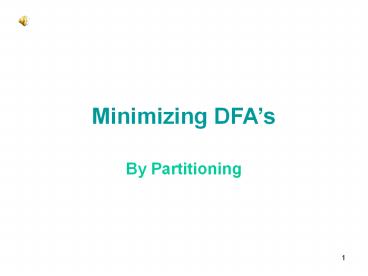Minimizing DFAs - PowerPoint PPT Presentation
Title:
Minimizing DFAs
Description:
States that go to equivalent states under all inputs (sounds recursive) ... Consider the following dfa (from Forbes Louis at U of KY): Accepting states are yellow ... – PowerPoint PPT presentation
Number of Views:67
Avg rating:3.0/5.0
Title: Minimizing DFAs
1
Minimizing DFAs
- By Partitioning
2
Minimizing DFAs
- Lots of methods
- All involve finding equivalent states
- States that go to equivalent states under all
inputs (sounds recursive) - We will use the Partitioning Method
3
Minimizing DFAs by Partitioning
- Consider the following dfa (from Forbes Louis at
U of KY)
- Accepting states are yellow
- Non-accepting states are blue
- Are any states really the same?
4
- S2 and S7 are really the same
- Both Final states
- Both go to S6 under input b
- Both go to S3 under an a
- S0 and S5 really the same. Why?
- We say each pair is equivalent
- Are there any other equivalent states?
- We can merge equivalent states into 1 state
5
Partitioning Algorithm
- First
- Divide the set of states into
- Final and
- Non-final states
- Partition I
- Partition II
6
Partitioning Algorithm
- Now
- See if states in each partition each go to the
- same partition
- S1 S6 are different from the rest of the states
in Partition I - (but like each other)
- We will move them to their own partition
7
Partitioning Algorithm
8
Partitioning Algorithm
- Now again
- See if states in each partition each go to the
same partition - In Partition I, S3 goes
- to a different partition
- from S0, S5 and S4
- Well move S3 to its own partition
9
Partitioning Algorithm
- Note changes in S6, S2 and S7
10
Partitioning Algorithm
- Now S6 goes to a different partition on an a from
S1 - S6 gets its own partition.
- We now have 5 partitions
- Note changes in S2 and S7
11
Partitioning Algorithm
- All states within each of the 5 partitions are
identical. - We might as well call the states I, II III, IV
and V.
12
Partitioning Algorithm
Here they are
13
b
b
b
V
b
a
a
a
a
b
a
b































